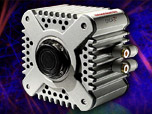Image Galleries
Featured Article
 Electron Multiplying Charge-Coupled Devices (EMCCDs)
Electron Multiplying Charge-Coupled Devices (EMCCDs)
By incorporating on-chip multiplication gain, the electron multiplying CCD achieves, in an all solid-state sensor, the single-photon detection sensitivity typical of intensified or electron-bombarded CCDs at much lower cost and without compromising the quantum efficiency and resolution characteristics of the conventional CCD structure.
Product Information
Interactive Flash Tutorials
Electron-Bombarded CCDs
Electron-bombarded charge-coupled devices (CCDs) are a relatively new development in which photons are detected by a photocathode in a manner similar to an image intensifier. Instructions for operation of the tutorial appear beneath the applet window.
Photons (yellow) impinging upon the surface of the photocathode liberate photoelectrons (red), which are accelerated by a high voltage gradient and impact on the back side of a CCD. Use the Gain slider to control the voltage supplied to the photocathode and, hence, the intensity or number of photoelectrons emitted by the photocathode.
The high-energy electrons that strike the CCD generate multiple charges resulting in a modest gain of a few hundred. The advantages of this device over a cooled, slow-scan CCD are the additional gain and accompanying speed; the main disadvantages are the lower quantum efficiency of the photocathode and diminished dynamic range.
Contributing Authors
Kenneth R. Spring - Scientific Consultant, Lusby, Maryland, 20657.
Christopher Steenerson and Michael W. Davidson - National High Magnetic Field Laboratory, 1800 East Paul Dirac Dr., The Florida State University, Tallahassee, Florida, 32310.






